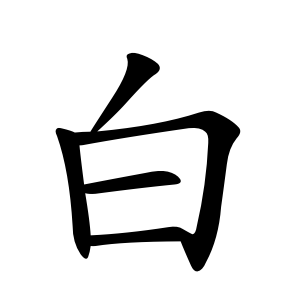白
- white, clean, clear;
- to explain, to report;
Etymology
It is considered either an ideogram or a combination of ideogram + phonetic. Due to its very simple form in oracle bone script (甲骨文, jiǎgǔwén), it is difficult to definitively identify what it originally depicted, leading to various scholarly theories:
1. One main theory is that it represents the burning wick of a candle, symbolizing "brightness," which extended to the meaning "white."
2. Another theory by Shirakawa Shizuka (시라카와 시즈카) suggests it depicts a skull (骸骨), with the color of bones being white, hence the meaning "white."
3. A theory by Kwak Mal-yak (곽말약) proposes it originated from the shape of a thumb, considered the "leader" of the fingers, thus explaining the meaning "leader" as well as "white," relating to the color of the thumbnail.
4. Some propose it comes from the shape of pine nuts (잣), linking it to the original form of 柏 (pine tree), or from the shape of rice grains, whose whiteness explains the meaning.
Among these, the "thumb theory" has gained the most support in linguistics because it neatly explains both the "leader" and "white" meanings.
Before oracle bone inscriptions were found, the prevailing view was that 白 depicted sunlight shining brightly above the 日 (sun) character, but this was later rejected because the oracle bone form is quite different from 日.
Additional notes
In modern times, because Belgium was phonetically transcribed into Chinese as 白耳義 (Baek-eui), the character 白 has sometimes been used as an abbreviation to refer to Belgium.
Characters with 白
- 竹日 (HA)
- ⿱ 丿 日
